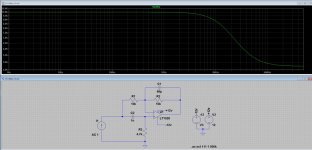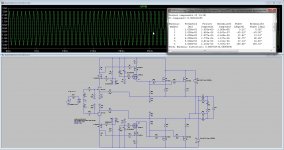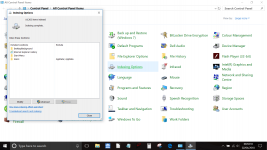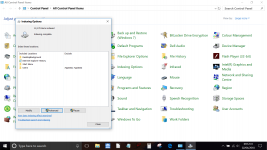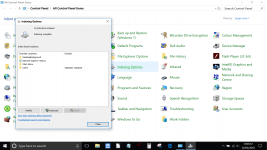Make your .asc file available, that will ease the discussion.the methods in posts 1096/7 give the same results for input impedance, however the results alter with the opamp used i.e. LT1028 13k2 at 100hz and 3k9 at 100k, whereas for a "universal opamp" I get 20k at 100hz and 3k9 at 100k.
I have my strong doubts about the OPA differences that you mention.
That's correct and since you seem to know this, look at the specs and correct this for the circuit that you use.I thought the circuitry used would define the output impedance....
If you want to really measure it, measure the output voltage V1 without load and V2 with load resistor.
Output impedance can now be calculated by Zout=Rload(V1-V2)/V2
@Mooly: just went through your guide for optimum FFT parameters, worked like a charm. Well done, many thanks for this.
Jan
Can you link to where this is? I'd like to compare to the settings I'm using.
I'm getting good FFT results, but I have to change the number of data points every time. The default value of 262144 is messing me up and it won't remember the setting between simulations.
I started to do a bit of math to see if I could get something that worked well with that value but never got it to where I want it.
The list of "topics" is in the first post in this thread.
That being said, it's a bit of a chore to manually calculate all the numbers to plug into the transient sim. Not 100% if or how much that might be related to your FFT issues, but a while ago i came across a "formulaic" set of values, where you can plug in parameters for the "important" numbers in your sim.
.tran 0 {(2+Cyc)/Freq} {Cyc/2/Freq} {(2+Cyc)/Freq/(FFT-1)} startup
This was used for simming some audio amplifiers, with the "Cyc" (number of cycles), "Freq" (frequency of the input signal) and FFT being set via ".param" directives.
I believe the minimum time-step should be directly related to the FFT size, in order to get the best results, but i stand to be corrected on that one.
That being said, it's a bit of a chore to manually calculate all the numbers to plug into the transient sim. Not 100% if or how much that might be related to your FFT issues, but a while ago i came across a "formulaic" set of values, where you can plug in parameters for the "important" numbers in your sim.
.tran 0 {(2+Cyc)/Freq} {Cyc/2/Freq} {(2+Cyc)/Freq/(FFT-1)} startup
This was used for simming some audio amplifiers, with the "Cyc" (number of cycles), "Freq" (frequency of the input signal) and FFT being set via ".param" directives.
I believe the minimum time-step should be directly related to the FFT size, in order to get the best results, but i stand to be corrected on that one.
Thanks, found it. I'm pretty sure I've looked at it before but had forgotten about the links to get back to it.
And yes, the optimum time-step is related to the FFT size.
I've got my own set of calculations based on number of cycles, frequency, etc., have managed to get it to work with the time-step being related to a power of 10 ( something like x/y*10^5), couldn't seem to get it to work with powers of 2. I ended up having to change the number of points to 100000 every time, which works, but is an extra step.
I'll have to have another go at it and see what I can come up with. I'm working on a whole setup for simulations to make it easy for me to run them with different values by changing .param statements.
And yes, the optimum time-step is related to the FFT size.
I've got my own set of calculations based on number of cycles, frequency, etc., have managed to get it to work with the time-step being related to a power of 10 ( something like x/y*10^5), couldn't seem to get it to work with powers of 2. I ended up having to change the number of points to 100000 every time, which works, but is an extra step.
I'll have to have another go at it and see what I can come up with. I'm working on a whole setup for simulations to make it easy for me to run them with different values by changing .param statements.
the .TRAN max time step should be small enough to cleanly show the behavior of the fastest component in your circuit
for discrete Q I would use 1 - 10 ns
if stability isn't an issue, say a standard audio frequency actrive filter, then maybe 100 ns
since Spice will take smaller steps as need to meet all of the accuracy settings there isn't a "minumum" time step
and since Spice will take nonuniform time steps the FFT time step math isn't important - a smoothing filter is applied to interpolate the .raw into uniform time steps for the FFT
the only 'requirement' would be to have more than 2x the time points than the length of the FFT
for discrete Q I would use 1 - 10 ns
if stability isn't an issue, say a standard audio frequency actrive filter, then maybe 100 ns
since Spice will take smaller steps as need to meet all of the accuracy settings there isn't a "minumum" time step
and since Spice will take nonuniform time steps the FFT time step math isn't important - a smoothing filter is applied to interpolate the .raw into uniform time steps for the FFT
the only 'requirement' would be to have more than 2x the time points than the length of the FFT
@Mooly: just went through your guide for optimum FFT parameters, worked like a charm. Well done, many thanks for this.
Jan
This Excel sheet is what I made for myself.
You can only enter data in the green fields until you get what you want.
Hans
Nice Hans!
is this it?Make your .asc file available, that will ease the discussion.
Attachments
ctrlx, you have your -12V wrong. You have it set as -12, with the + to ground and output from the -. You have to either flip it over so - is to ground and output is from +, or change it to 12V without the - sign. Basically you're making it negative twice which cancels out and makes the output +12V.
Thanks guys - the psu was the problem, I changed v3 to 12 (from -12)
the input imp is now 10k at LF and 4.7k at HF
With the circuit now working properly, I also can see the load placed on the opamp (opamp Vout/opamp Iout) which is 10k for all frequencies... adding an additional 10K load increases the overall loading to 5k (as expected) (both tests done using voltage input source)
can you give me some more detail regarding the output impedance setup?
the input imp is now 10k at LF and 4.7k at HF
With the circuit now working properly, I also can see the load placed on the opamp (opamp Vout/opamp Iout) which is 10k for all frequencies... adding an additional 10K load increases the overall loading to 5k (as expected) (both tests done using voltage input source)
can you give me some more detail regarding the output impedance setup?
can you give me some more detail regarding the output impedance setup?
If you're using the current source method just move current source to the output and ground the input.
Hi All
I get a hanging sim, jumps just between defcon 1, 2 on 15 procent, maybe oscillation in the amp, but these did wel a while ago, I have a tread of also, it is a circlotron.
Maybe someone now what happens?, maybe I do have a wrong setup.
I have found that the 32 bit old version do well. after look at it, it seems the standard setup is different in the 64 bit version, alternate is there normal, setting it also alternate it did work.
regards
I get a hanging sim, jumps just between defcon 1, 2 on 15 procent, maybe oscillation in the amp, but these did wel a while ago, I have a tread of also, it is a circlotron.
Maybe someone now what happens?, maybe I do have a wrong setup.
I have found that the 32 bit old version do well. after look at it, it seems the standard setup is different in the 64 bit version, alternate is there normal, setting it also alternate it did work.
regards
Attachments
Can anyone walk me through changing file permissions to be able to edit the standard.bjt file so i can add some more models. Its is win10-64, still using ltspice IV.
I am admin, but it still complains I do not have permission when I do a file save using Notepad. the cmp folder I can't turn off the read only attribute it seems.
Tried to change all the way up to program Files(x86) folder.
In the mean time I'll keep trying
Thx and happy easter too
Rick
I am admin, but it still complains I do not have permission when I do a file save using Notepad. the cmp folder I can't turn off the read only attribute it seems.
Tried to change all the way up to program Files(x86) folder.
In the mean time I'll keep trying
Thx and happy easter too
Rick
Last edited:
Is LTXVII causing an indexing problem ?...
I've noticed that my indexed files keeps growing and growing. This behaviour has been going on for months and I suspect LTXVII might be the culprit with its duplicate lib files appearing in documents and the program files.
I checked the number of indexed files this morning and it was over 19,000 in size. I get W10 to rebuild the index and sure enough, that total drops by over 7000. Now, through the course of the day the total is slowly increasing again. It will take a week or two (or three ) to get back to where it was. That number of 7000 or so seems to approximate to the number of items in the documents .lib folder, at least that is the number of items I see clock up if I copy the folder to a USB drive.
) to get back to where it was. That number of 7000 or so seems to approximate to the number of items in the documents .lib folder, at least that is the number of items I see clock up if I copy the folder to a USB drive.
I've noticed that my indexed files keeps growing and growing. This behaviour has been going on for months and I suspect LTXVII might be the culprit with its duplicate lib files appearing in documents and the program files.
I checked the number of indexed files this morning and it was over 19,000 in size. I get W10 to rebuild the index and sure enough, that total drops by over 7000. Now, through the course of the day the total is slowly increasing again. It will take a week or two (or three
Attachments
- Home
- Design & Build
- Software Tools
- Installing and using LTspice IV (now including LTXVII), From beginner to advanced
